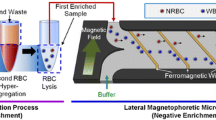Summary
To find a simple, effective method of isolating fetal cells from maternal peripheral blood for prenatal diagnosis, 45 women were studied with their gestation being 6–14 weeks and age 21–30 years. The fetal cells were isolated from maternal blood by using discontinuous density gradient centrifugation. Some of the isolated cells were made smear and counted under the microscope; others were used for predicting fetal sex by PCR amplification of Y chromosome specific DYZ1 gene. The major cells in the upper separation interface were lymphocytes and monocytes, with occasionally seen nucleated red blood cells (NRBC); while those in the middle separation interface were neutrocytes, with NRBC scattering. The ratio of NRBC/nucleated cells was 1. 98±0.28×10−5. There was no significant difference between the first and second trimester (P>0.05). The amount of isolated fetal cells was sufficient for prenatal genetic diagnosis. Male pregnancy was correctly predicted in 10 out of 13 cases. It is concluded that the method of discontinuous density gradient centrifugation was of considerable importance in the development of non-invasive prenatal genetic diagnosis.
Similar content being viewed by others
Referances
Walknowska J, Conte F A, Grumbach M Met al. Practical and theoretical implications of fetal/maternal lymphocyte transfer. Lancet, 1969, 1:1119
1995,13(2):114
Takabayashi H, Kuwabara S, Ukita Tet al. Development of non-invasive fetal DNA diagnosis from maternal blood. Prenat Diagn, 1995, 15:74
Sekizawa A, Watanabo A, Kimura Tet al. Prenatal diagnosis of the fetal RhD blood type using a single fetal nucleated erythrocyte from maternal blood. Obstet Gynecol, 1996, 87(4): 501
Thomas M R, Tutschek B, Frost Aet al. The time of appearance and disappearance of fetal DNA from the maternal circulation. Prenat Diagn, 1995, 15(7):641
Thilaganathan B, Meker-Homji N J, Nicolaides K Het al. Blood transferrin receptor expression in chromosomally abnormal fetuses. Prenat Diagn, 1995, 15(3):282
Korst L M, Phelan J P, Ahn M Oet al. Nucleated red blood cells: An update on the marker for fetal asphyxia. Am J Obstet Gynecol, 1996, 175(4 Pt I):843
Hume R, Pazouki S, Hallas Aet al. The ontogeny of the glucose-6-phosphatase enzyme in human embryonic and fetal red blood cells. Early Hum Dev, 1995, 42(2):85
Lo Y M, Corbetta N, Chamberlain P Fet al. Presence of fetal DNA in maternal plasma and serum. Lancet, 1997, 350(9076):485
Author information
Authors and Affiliations
Rights and permissions
About this article
Cite this article
Li, Z., Xiaojing, Y., Keshu, X. et al. Isolation of fetal nucleated red blood cells from maternal blood. Current Medical Science 20, 169–171 (2000). https://doi.org/10.1007/BF02887064
Received:
Published:
Issue Date:
DOI: https://doi.org/10.1007/BF02887064




